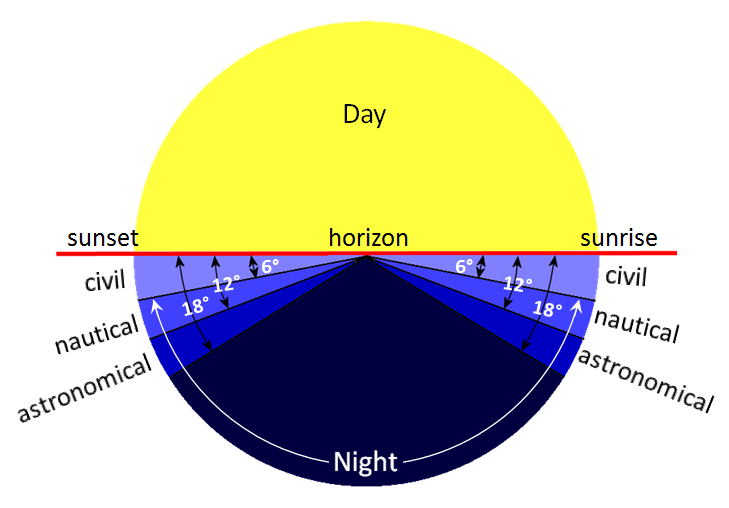In its most general sense, twilight is the period of time before sunrise and after sunset, in which the atmosphere is partially illuminated by the sun, being neither totally dark or completely lit. However there are three categories of twilight that are defined by how far the sun is below the horizon.
Civil Twilight:
- Begins in the morning, or ends in the evening, when the geometric center of the sun is 6 degrees below the horizon. Therefore morning civil twilight begins when the geometric center of the sun is 6 degrees below the horizon, and ends at sunrise. Evening civil twilight begins at sunset, and ends when the geometric center of the sun is 6 degrees below the horizon. Under these conditions absent fog or other restrictions, the brightest stars and planets can be seen, the horizon and terrestrial objects can be discerned, and in many cases, artificial lighting is not needed. Civil Twilight is also known as Civil Dawn and Civil Dusk.
Nautical Twilight:
- Begins in the morning, or ends in the evening, when the geometric center of the sun is 12 degrees below the horizon. In general, the term nautical twilight refers to sailors being able to take reliable readings via well known stars because the horizon is still visible, even under moonless conditions. Absent fog or other restrictions, outlines of terrestrial objects may still be discernible, but detailed outdoor activities are likely curtailed without artificial illumination. Nautical Twilight is also known as Nautical Dawn and Nautical Dusk.
Astronomical Twilight:
- Begins in the morning, or ends in the evening, when the geometric center of the sun is 18 degrees below the horizon. In astronomical twilight, sky illumination is so faint that most casual observers would regard the sky as fully dark, especially under urban or suburban light pollution. Under astronomical twilight, the horizon is not discernible and moderately faint stars or planets can be observed with the naked eye under a non light polluted sky. But to test the limits of naked eye observations, the sun needs to be more than 18 degrees below the horizon. Point light sources such as stars and planets can be readily studied by astronomers under astronomical twilight. But diffuse light sources such as galaxies, nebula, and globular clusters need to be observed under a totally dark sky, again when the sun is more than 18 degrees below the horizon.
The figure below shows civil, nautical and astronomical twilight. Note that the angles are not to scale so as to show the three twilight categories with more clarity.

Source: https://w1.weather.gov/glossary/
